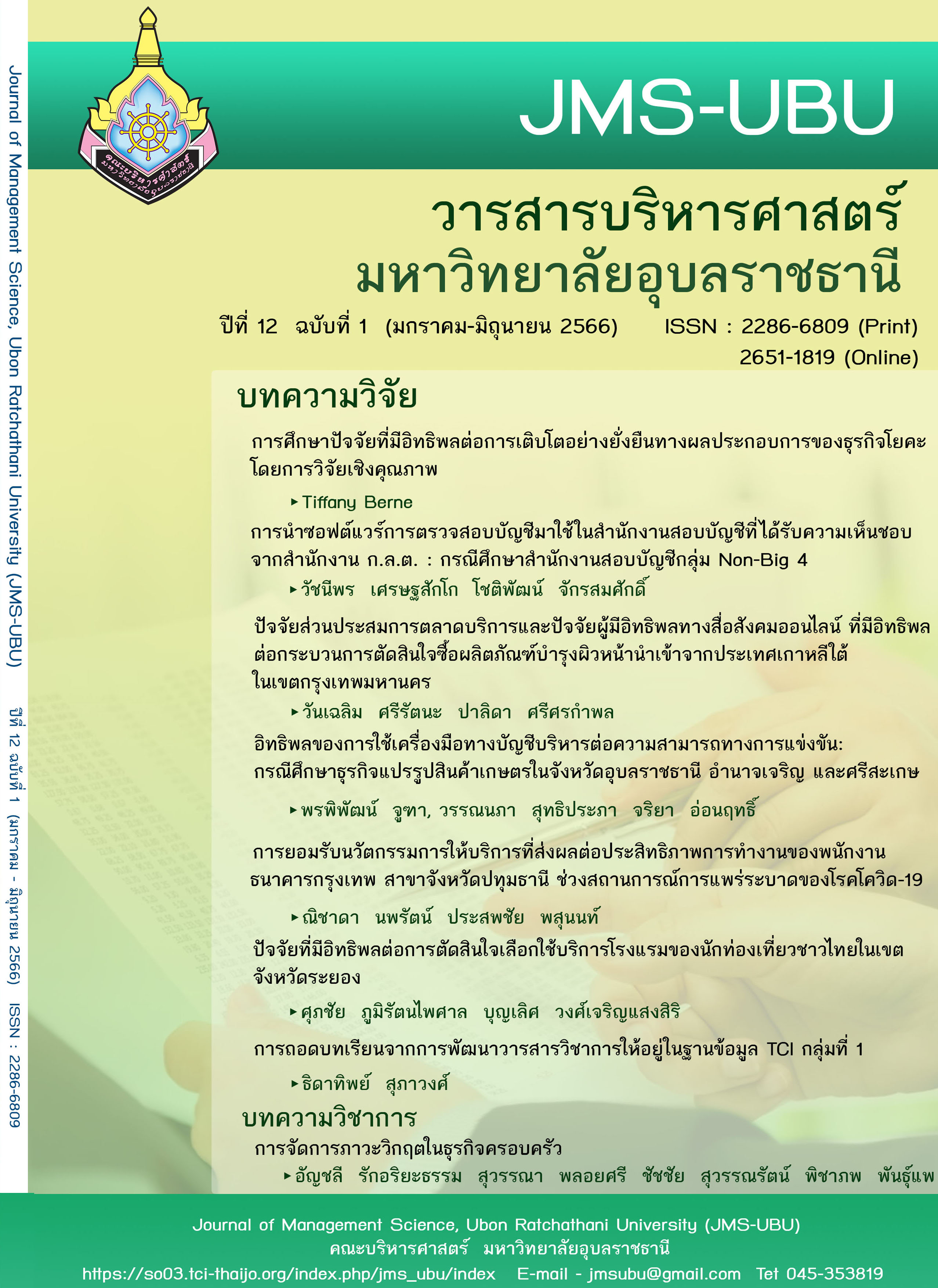การศึกษาปัจจัยที่มีอิทธิพลต่อการเติบโตอย่างยั่งยืนทางผลประกอบการของธุรกิจโยคะโดยการวิจัยเชิงคุณภาพ
Main Article Content
บทคัดย่อ
โยคะเติบโตอย่างรวดเร็วทั่วโลก ในช่วงทศวรรษที่ผ่านมาความต้องการเรียนโยคะขยายไปทั่วโลกส่งผลให้มีผู้ประกอบการโยคะจำนวนมากเข้าสู่อุตสาหกรรมนี้ อย่างไรก็ตามหลายคนเผชิญกับความท้าทายในการเติบโตและรักษาธุรกิจของตนไว้ แม้ว่าโยคะจะเกี่ยวข้องกับการปฏิบัติทางจิตใจที่อาจตรงกันข้ามกับความคาดหวังให้ผลประกอบการเพิ่มขึ้น แต่ผลกำไรเป็นสิ่งสำคัญในทุกธุรกิจรวมถึงอุตสาหกรรมโยคะด้วย ผู้ประกอบการโยคะต้องการความรู้เพิ่มเติมเกี่ยวกับปัจจัยที่มีอิทธิพลต่อความสำเร็จของธุรกิจ ดังนั้นการศึกษานี้จึงมุ่งเน้นไปที่การเติบโตของกำไรและความมั่นคงทางธุรกิจตามนิยามขององค์ประกอบทางด้านเศรษฐกิจในทฤษฎีความยั่งยืน (TBL) การศึกษานี้มีวัตถุประสงค์เพื่อ (1) สำรวจว่าคุณค่าทางสังคมส่งผลต่อกำไรและความมั่นคงทางธุรกิจในธุรกิจโยคะอย่างไร (2) สำรวจว่าส่วนประสมทางการตลาดของ 7P’s ส่งผลต่อกำไรและความมั่นคงทางธุรกิจในธุรกิจโยคะอย่างไร
การศึกษาใช้วิธีการเชิงคุณภาพด้วยการศึกษาเชิงสำรวจโดยการสัมภาษณ์แบบกึ่งโครงสร้างและวิเคราะห์ข้อมูลโดยการวิเคราะห์เนื้อหาเพื่อให้บรรลุวัตถุประสงค์ของการวิจัย สืบเนื่องจากการที่โยคะเป็นธุรกิจระหว่างประเทศ มีกลุ่มตัวอย่างจำนวน 21 คน ได้แก่ เจ้าของธุรกิจโยคะ ครูสอนโยคะ และที่ปรึกษาทางวิชาการ มาจาก 3 ภูมิภาค ได้แก่ อเมริกาเหนือ ยุโรป และเอเชียแปซิฟิก
ผลสรุปการวิจัยพบว่าคุณค่าทางสังคมและส่วนประสมทางการตลาด 7P’s ส่งผลต่อผลกำไรและความมั่นคงของธุรกิจโยคะ อย่างไรก็ตาม ผลกระทบของแต่ละองค์ประกอบจะเกี่ยวข้องกับประเภทของการบริการและกลุ่มลูกค้า คุณภาพการบริการ นโยบายและบุคลากรเป็นองค์ประกอบที่สำคัญที่สุดสามอันดับแรก ที่มีอิทธิพลต่อรายได้และการเติบโต นอกจากนี้การศึกษายังให้คำจำกัดความเชิงปฏิบัติของส่วนประสมทางการตลาดที่มีประสิทธิภาพสำหรับธุรกิจโยคะ นอกจากนี้คุณค่าทางสังคมในธุรกิจโยคะในการศึกษานี้หมายถึงการสร้างชุมชนที่เข้มแข็งซึ่งส่งผลกระทบอย่างยิ่งต่อความภักดีของลูกค้าและการขยายธุรกิจ และสุดท้าย ภูมิภาคไม่มีผลกระทบต่อมุมมองของผู้ประกอบการโยคะเกี่ยวกับวิธีการดำเนินธุรกิจโยคะของตน
Downloads
Article Details

อนุญาตภายใต้เงื่อนไข Creative Commons Attribution-NonCommercial-NoDerivatives 4.0 International License.
บทความที่ตีพิมพ์ในวารสารบริหารศาสตร์ มหาวิทยาลัยอุบลราชธานี เป็นลิขสิทธิ์ของวารสาร โดยเนื้อหาและความคิดเห็นในบทความเป็นความรับผิดชอบของผู้เขียนแต่ละท่าน ไม่เกี่ยวข้องกับคณะบริหารศาสตร์ มหาวิทยาลัยอุบลราชธานีแต่อย่างใด และหากมีข้อผิดพลาดประการใด ผู้เขียนจะเป็นผู้รับผิดชอบต่อบทความของตนเองแต่เพียงผู้เดียว
เอกสารอ้างอิง
Allan, B. A., Batz-Barbarich, C., Stering, H. M., & Tay, L. (2019). Outcomes of meaningful work: A meta-analysis. Journal of Management Studies, 56(3), 500-528.
Allied Market Research. (2020). Yoga market by type (online yoga course, offline yoga course, and yoga accreditation training programs): Global opportunity analysis and industry forecast, 2021-2027. Retrieved December 6, 2021, from https://www.alliedmarketresearch.com/yoga-market-A06967?fbclid=IwAR3wr7vlLRZcZlg3JuvTlZlTifxl9yHvGYaS5z0g-n5AKFNsPHPSIDcdMzs
Boeger, N. (2017). Reappraising the UK social value legislation. Public Money & Management, 37(2), 113-120.
Boykin, J., Leitheiser, J., & Martin, F. (2015). The HPT model applied to a yoga studio's performance. Performance Improvement, 54(1), 28-38.
Braccini, A. M., & Margherita, E. G. (2019). Exploring organizational sustainability of industry 4.0 under the triple bottom line: The case of a manufacturing company. Sustainability, 11(1). DOI:10.3390/su11010036
Bryman, A., & Bell, E. (2015). Business Research Methods (4th ed.). Oxford: Oxford University Press.
Cambridge City Council (2012). Social value: Procurement guidance. Retrieved January 17, 2022, from https://www.cambridge.gov.uk/media/3076/procurement-guidance-social-value.pdf
Dworkin, S. L. (2012). Sample size policy for qualitative studies using in-depth interviews. Archives of Sexual Behavior, 41, 1319-1320.
Evans, S., Vladimirova, D., Holgado M., Fossen, K., Yang, M., Silva E. A., & Barlow. (2017). Business model innovation for sustainability: Towards a unified perspective for creation of sustainable business models. Business Strategy and the Environment, 26(5), 597–608.
Growjo (2022a). Yoga international revenue and competitors. Retrieved February 12, 2022, from https://growjo.com/company/Yoga_International
Growjo (2022b). Glo revenue and competitors. Retrieved Februay14, 2022, from https://growjo.com/company/Glo
Hufnagel, J. (2020). Individual spirituality and business sustainability (Doctoral Thesis). Technischen Universität Kaiserslautern.
IBISWorld (2021a). Pilates and yoga studios in Australia - Market Research Report. Retrieved Februay 14, 2022, from https://www.ibisworld.com/au/industry/pilates-yoga-studios/4198/
IBISWorld (2021b). Pilates & yoga studios in the UK-Market research report. Retrieved February 14, 2022, from https://www.ibisworld.com/united-kingdom/market-research-reports/pilates-yoga-studios-industry/
IBISWorld (2021c). Pilates & yoga studios industry in the US-market research report. Retrieved January 6, 2022, from https://www.ibisworld.com/united-states/market-research-reports/pilates-yoga-studios-industry/
Ipos Public Affairs (2016). Yoga in America study. Retrieved Februay14, 2022, from https://www.academia.edu/37839276/Yoga_in_America_Study
Jeong, S. (2022). Yoga industry statistics, facts, demographics & infographic. Retrieved Janury 3, 2022, from https://www.yogitimes.com/article/unstoppable-trend-yoga-infographic-business
Krippendorff, K. ( 2018 ) Content Analysis an Introduction to Its Methodology. New York: Publisher SAGE.
Lusnia, K. (2022). Additional revenue streams for profitable yoga studios. Retrieved January 3, 2022, from https://gymdesk.com/blog/additional-revenue-streams-for-profitable-yoga-studios/
McCall, M. C. (2014). In search of yoga: Research trends in a western medical database. International Journal of Yoga, 7(1), 4-8.
Mirsha, S., & Sharma, V. (2015). Excellence driven sustainability in business through the prism of Vedanta. Procedia-Social and Behavioral Sciences. 189, 351-355.
Net Worth Spot. ( 2022). Alo yoga net worth & earnings. Retrieved January 6, 2022, from https://www.networthspot.com/aloyoga/net-worth/instagram/
People Ai (2022). Kino MacGregor net worth. Retrieved from February 14, 2022, from https://peopleai.com/fame/identities/kino-macgregor
Porter, M. E., & Kramer, M. R. (2011). Creating shared value: How to reinvent capitalism-and unleash a wave of innovation and growth. Harvard Business Review. Retrieved December 15, 2021, from https://hbr.org/2011/01/the-big-idea-creating-shared-value
Pratiwi, D. (2021). Creating shared value (CSV) based on the system in yoga related to corporate awareness in the practice of corporate social responsibility (CSR). The Indonesian Accounting Review, 11(1). DOI: 10.14414/tiar.v11i1.1929
Rachmawatia,T., Basuki, B., & Hamidah, H. (2019). Creating share valued (CSV): The sustainable business model. International Journal of Innovation, Creativity and Change, 8(9), 262-269.
Raiden, A., Loosemore, M., King, A., & Gorse, C. (2019). Social Value in Construction (1st ed.). London: Routledge.
Reihani, E., & Khatibzadeh M. (2021). Marketing mix in sport tourism context. Journal of New Studies in Sport Management, 2(3), 247-255.
Saunders, M. N. K., Lewis, P., & Thornhill, A. (2020). Research Methods For Business Students (8th ed.). London: Pearson.
Smith, M. K., & Sziva, I. (2016). Yoga, transformation and tourism. The Routledge Handbook of Health Tourism (1st ed.). New York: Routledge.
Stock Analysis (2022). Gaia, Inc. (GAIA). Retrieved February 14, 2022, from https://stockanalysis.com/stocks/gaia/statistics/
Tellerove, T. (2017). A marketing mix analysis for a Czech fitness centre. (Bachelor thesis). Tomas Bata University in Zlin. Retrieved December 16, 2021, from http://digilib.k.utb.cz/handle/10563/40133
Tracy, B. L., & Hart, C. E. (2013). Bikram yoga training and physical fitness in healthy young adults. Journal of Strength and Conditioning Research, 27(3), 822-830.

